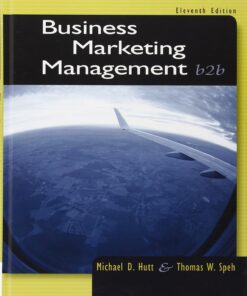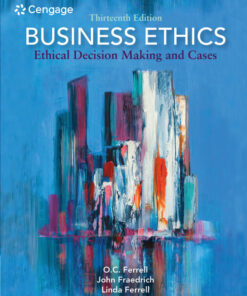Solution Solution For An Introduction to Management Science Quantitative Approaches to Decision Making, 16th Edition Jeffrey D. Camm
$55.00
- Publisher : Cengage Learning; 16th edition (March 29, 2022)
- Language : English
- ISBN-10 : 0357715462
- ISBN-13 : 978-0357715468
You will receive this product within 24 hours after placing the order
Solution Solution For An Introduction to Management Science Quantitative Approaches to Decision Making, 16th Edition Jeffrey D. Camm
Solution and Answer Guide
Jeffrey D. Camm, An Introduction to Management Science 2023, 9780357715468; Chapter 1: Introduction
Table of Contents
Problems 1
Case Problem: Scheduling a Youth Soccer League 12
Problems
1. Vocabulary. Define the terms management science and operations research. LO 1
Solutions:
Management science and operations research, terms used almost interchangeably, are broad disciplines that employ scientific methodology in managerial decision making or problem solving. Drawing upon a variety of disciplines (behavioral, mathematical, etc.), management science and operations research combine quantitative and qualitative considerations in order to establish policies and decisions that are in the best interest of the organization.
2. The Decision-Making Process. List and discuss the steps of the decision-making process. LO 2
Solutions:
- Define the problem.
- Identify the alternatives.
- Determine the criteria.
- Evaluate the alternatives.
- Choose an alternative.
- For further discussion, see Section 1.3.
3. Roles of Qualitative and Quantitative Approaches to Decision Making. Discuss the different roles played by the qualitative and quantitative approaches to managerial decision making. Why is it important for a manager or decision maker to have a good understanding of both of these approaches to decision making? LO 2
Solutions:
See Section 1.2.
4. Production Scheduling. A firm just completed a new plant that will produce more than 500 different products, using more than 50 different production lines and machines. The production scheduling decisions are critical in that sales will be lost if customer demands are not met on time. If no individual in the firm has experience with this production operation and if new production schedules must be generated each week, why should the firm consider a quantitative approach to the production scheduling problem? LO 2
Solutions:
A quantitative approach should be considered because the problem is large, complex, important, new, and repetitive.
5. Advantages of Modeling. List the advantages of analyzing and experimenting with a model as opposed to a real object or situation. LO 3
Solutions:
Models usually have time, cost, and risk advantages over experimenting with actual situations.
6. Choosing Between Models. Suppose that a manager has a choice between the following two mathematical models of a given situation: (a) a relatively simple model that is a reasonable approximation of the real situation, and (b) a thorough and complex model that is the most accurate mathematical representation of the real situation possible. Why might the model described in part (a) be preferred by the manager? LO 3
Solutions:
Model (a) may be quicker to formulate, easier to solve, and/or more easy to understand.
7. Modeling Fuel Cost. Suppose you are going on a weekend trip to a city that is d miles away. Develop a model that determines your round-trip gasoline costs. What assumptions or approximations are necessary to treat this model as a deterministic model? Are these assumptions or approximations acceptable to you? LO 3
Solutions:
Let d = distance
m = miles per gallon
c = cost per gallon,
Total Cost =
We must be willing to treat m and c as known and not subject to variation.
8. Adding a Second Product to a Production Model. Recall the production model from
Section 1.3:
Max 10x
s.t.
5x ≤ 40
x ≥ 0
Suppose the firm in this example considers a second product that has a unit profit of $5 and requires 2 hours of production time for each unit produced. Use y as the number of units of product 2 produced. LO 4
a. Show the mathematical model when both products are considered simultaneously.
b. Identify the controllable and uncontrollable inputs for this model.
c. Draw the flowchart of the input–output process for this model (see Figure 1.5).
d. What are the optimal solution values of x and y?
e. Is the model developed in part (a) a deterministic or a stochastic model? Explain.
Solutions:
a. Maximize 10x + 5y
s.t.
5x + 2y ≤ 40
x ≥ 0, y ≥ 0
b. Controllable inputs: x and y
Uncontrollable inputs: profit (10,5), labor hours (5,2), and labor-hour availability (40)
c.
d. x = 0, y = 20 Profit = $100
(Solution by trial-and-error)
e. Deterministic—all uncontrollable inputs are fixed and known.
9. Stochastic Production Models. Suppose we modify the production model in Section 1.3 to obtain the following mathematical model:
Max 10x
s.t.
ax ≤ 40
x ≥ 0
where a is the number of hours of production time required for each unit produced. With
a = 5, the optimal solution is x = 8. If we have a stochastic model with a = 3, a = 4,
a = 5, or a = 6 as the possible values for the number of hours required per unit, what is the optimal value for x? What problems does this stochastic model cause? LO 4
Solutions:
If a = 3, x = 13 1/3, and profit = 133.
If a = 4, x = 10, and profit = 100.
If a = 5, x = 8, and profit = 80.
If a = 6, x = 6 2/3, and profit = 67.
Since a is unknown, the actual values of x and profit are not known with certainty.
10. Modeling Shipments. A retail store in Des Moines, Iowa, receives shipments of a particular product from Kansas City and Minneapolis. Define x and y as follows. LO 4
x = number of units of the product received from Kansas City
y = number of units of the product received from Minneapolis
a. Write an expression for the total number of units of the product received by the retail store in Des Moines.
b. Shipments from Kansas City cost $0.20 per unit, and shipments from Minneapolis cost $0.25 per unit. Develop an objective function representing the total cost of shipments to Des Moines.
c. Assuming the monthly demand at the retail store is 5000 units, develop a constraint that requires 5000 units to be shipped to Des Moines.
d. No more than 4000 units can be shipped from Kansas City, and no more than 3000 units can be shipped from Minneapolis in a month. Develop constraints to model this situation.
e. Of course, negative amounts cannot be shipped. Combine the objective function and constraints developed to state a mathematical model for satisfying the demand at the Des Moines retail store at minimum cost.
Solutions:
a. Total Units Received = y
x +
b. Total Cost = 0.20x + 0.25y
c. x + y = 5000
d. x ≤ 4000 Kansas City Constraint
y ≤ 3000 Minneapolis Constraint
e. Min 0.20x + 0.25y
s.t.
x + y = 5000
x ≤ 4000
y ≤ 3000
x, y ≥ 0
Be the first to review “Solution Solution For An Introduction to Management Science Quantitative Approaches to Decision Making, 16th Edition Jeffrey D. Camm” Cancel reply
Related products
Business And Management
Business Ethics Case Studies and Selected Readings, 10th Edition Marianne M. Jennings
Business And Management
Business Marketing Management B2B, 13th Edition Michael D. Hutt
Business And Management
Business And Management
Business Ethics Ethical Decision Making and Cases, 13th Edition O. C. Ferrell
Business And Management









Reviews
There are no reviews yet.